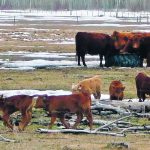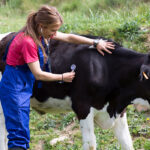Spring has arrived on the Prairies and that means our horses are shedding their puffy winter coats in favour of their short, sleek summer look. With less hair on their bodies, it is a good idea to take a few minutes to assess visual health indicators. Spring is an important time to determine your horse’s […] Read more
Stories by Jamie Rothenburger, DVM

Play may be important part of animal welfare
We’ve all seen exuberant play behaviours in various animal species. Puppies roughhousing, fighting, gnawing and gnashing their teeth. Dogs bowing to initiate play. Kid goats leaping off structures and butting heads. Kittens chasing anything that moves. Foals bucking, nipping and kicking at their herd mates. You get the idea. There is growing recognition of the […] Read more

Coyotes seen as possible source of mange for farm dogs
Coyotes are ubiquitous on the Canadian prairie landscape. In rural and urban areas, coyote populations are thriving. A disease frequently associated with coyotes is mange, one of the most visible and severe diseases to affect wild animals. A survey of coyotes in British Columbia found that about one in four had skin disease consistent with […] Read more

White-tailed deer potential reservoir for COVID-19 virus
At the start of the COVID-19 pandemic, there were many unknowns. Where did the virus come from? What are the main disease manifestations? Certainly, many public health experts and veterinarians were also wondering: will it infect animals? Within a few months, we had some answers, including insight into the animal situation. The virus can infect […] Read more

Measures can be taken to prevent mercury poisoning
We’ve come a long way from the days of “mad hatters.” Historically, hat makers, who used mercury in the process of turning the pelts of beaver and other fur-bearing animals (many of which originated in Canada) into luxury top hats, suffered from severe, debilitating neurological disease. Nowadays, the most common ways that people encounter mercury […] Read more

Skin tumour removal in horses can be tricky business
A lump or bump on your horse’s skin is most likely a sarcoid. These are the most common type of skin tumours found in horses and other equids like donkeys and mules. Some studies have estimated that up to 12 percent of horses will develop sarcoids in their lifetime. Their appearance can range from rough, […] Read more

Veterinary shortage appears to be a long-term problem
When I graduated from the Western College of Veterinary Medicine in 2010, there were only a handful of advertised jobs. I was hired by a rural practice near Calgary through a lucky word-of-mouth connection—vet positions in this area were in short supply. Times have changed. Now veterinary professional publications feature pages of vet wanted ads, […] Read more

Antimicrobial resistance can cause problems in horses
The COVID-19 pandemic is likely to go down in history as the defining public health event of our lifetime. The issue of antimicrobial resistance will too, albeit it will be remembered as more of a slow burn rather than an explosive event. Bacteria resistant to antimicrobial drugs have been around since the first of these […] Read more

Pet owners are often best to decide when to euthanize
He inhaled his last breath, went limp in my arms and was gone. Deciding to euthanize my cat, Tomba, was a difficult decision. He warmed my lap while I studied for every exam during my four years of veterinary school. It was his joints I manipulated to learn anatomy and his eyes I stared into […] Read more

New study explores West Nile cases in Canadian horses
A 2021 study by Antoine Levasseur and colleagues published in the Canadian Veterinary Journal analyzed cases of West Nile virus infection in horses across the country. The study included cases starting in 2003 when the disease was designated as an immediately notifiable disease. From 2003-19 there were 842 cases of this disease in horses reported […] Read more




